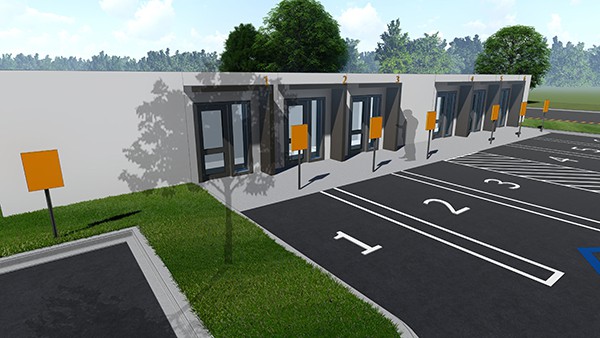Blog
The Clinic of the Future Utilizes Modular Techniques and Offers a Near Touchless Experience

The clinic of the future thought up by Brian Adams, AIA, Senior Healthcare Planner at Catalyst, a Division of Haskell makes a lot of sense. First, it utilizes modular techniques which lower construction costs and allow for room adaptability. On top of that, the clinic design can be fashioned to existing retail strip centers and restaurant sites for alternate site locations. Beyond that, the design concept eliminates the need for waiting rooms and common areas resulting in a near touchless experience. Check out the article recently published on the Catalyst website for the full story or enjoy a summary below.
The Clinic of the Future
By Brian Adams, AIA, Senior Healthcare Planner
Telehealth visits, plexiglass partitions, taped-off waiting room chairs, hand sanitizer stations, and masks are just a sample of the changes we have experienced in the last year while visiting our healthcare providers. At the same time, providers were strapped with lost revenue, escalating costs to quickly initiate safety protocols for staff and patients, and the effects of full implementation of new technology.
While some of the changes within the healthcare delivery model have been progressing slowly over the last couple of years, the pandemic spurred implementation into warp speed. Now that we are starting to get used to these changes and have implemented stop-gap design solutions, what have we learned to create a design vision for the healthcare clinic of the future?

- Freestanding/Outpatient Access Sites Within the Community
- Customizable Experiences Based On the Reason For Your Visit
- No Lobby, Elevator or Waiting Room
- Parking Space Check In Like Those For To-Go Orders at Restaurants Where Patients Text Upon Arrival
- Scheduled Appointments Are Assigned Single Entry Exam Rooms, Waiting is Done in the Car and the Full Appointment Including Vitals, Registration, Exam and Financial Discussion All TAke Place In the Dedicated Exam Room
- Drive-Thru Testing and Lab Services
- Rooms Designed to Respond to Numerous Clinical Needs
- Quicker Speed To Market Solution
- Adaptability to Allow for Both New Construction Concepts and Re-Use and Renovation of Existing Spaces
- Takes Advantage of Great Site Access and the Parking Required for Successful Clinic Use
- The Modular Framework Can Be Quickly Adapted to Final Site Selection and Allow for Quicker Construction Times
- The Exam Room Module Can Be Standardized and Built in Its Entirety off-Site and Dropped Into the Existing Building
- Using the Modular Framework Will Improve the Patient and Staff Experience, Reduce Ongoing Operational Costs, and Minimize Upfront Construction Costs Through Reduced Design Time and Fees
- takes advantage of great site access and the parking required for successful clinic use.

Read this article in its original form
Marie Wikoff is the creator of Wikoff Design Studio based out of Reno, Nevada. Her expertise in healthcare design has helped modernize healthcare organizations locally, regionally, and internationally, improving patient experience and outcomes. Her credentials include Evidence-Based Design Accreditation and Certification (EDAC), American Academy of Healthcare Interior Designer (CHID), the National Council of Interior Design Qualification (NCIDQ) and LEED AP. Contact Marie Wikoff
Source
Brian Adams, AIA, Senior Healthcare Planner. “The Clinic of the Future.” Catalyst, 16 Feb. 2021, catalysthc.com/2021/02/16/the-clinic-of-the-future/.







